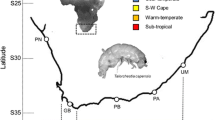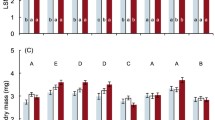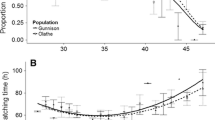Abstract
Insect species can respond adaptively to stress temperature conditions including both thermal limits and reaction norms. In this study, we considered two populations of the whitefly Bemisia tabaci (Gennadius), in which adaptive differentiation was detected for tolerance to upper thermal limits. These two populations are found in two regions of Colombia with climatic differences: the Caribbean region with high environmental temperatures and the Southwest region with lower temperature regimens. We assessed the thermal responses to a range of 1 h heat shocks (37, 39, 41, 43 and 44 °C) performed below the thermal limits for this species. Thermal responses were measured using three life-history traits involved in fitness: survival, fecundity and viability of the offspring after heat shocks. Survival or fecundity as a response to heat shocks did not differ among populations; however, there were significantly different responses for viability between populations. The Southwestern population showed higher viability responses to low heat shocks than the Caribbean population. This relationship suggests a potential trade-off, which appears to be associated with climatic regions. In addition, these results suggest that adaptation under thermal limits does not necessarily involve similar responses throughout the reaction norm. A potential ongoing evolutionary response is taking place through the thermal reaction norms for viability after the invasion by this pest in Colombia.
Similar content being viewed by others
References
Abd-Rabou S. and Simmons A. M. (2014) Survey of natural enemies of whiteflies (Hemiptera: Aleyrodidae) in Egypt with new local and world records. Entomological News 124, 38–56.
Bahrndorff S., Holmstrup M., Petersen H. and Loeschcke V. (2006) Geographic variation for climatic stress resistance traits in the springtail Orchesella cincta. Journal of Insect Physiology 52, 951–959.
Bowler K. and Terblanche J. S. (2008) Insect thermal tolerance: what is the role of ontogeny, ageing and senescence? Biological Reviews 83, 339–355.
Cuéllar M. E. and Morales F. J. (2006) La mosca blanca Bemisia tabaci (Gennadius) como plaga y vectora de virus en fríjol común (Phaseolus vulgaris L.). Revista Colombiana de Entomología 32, 1–9.
Cui X., Wan R, Xie M. and Liu T. (2008a) Effects of heat shock on survival and reproduction of two whitefly species, Trialeurodes vaporariorum and Bemisia tabaci biotype B. Journal of Insect Science 8, 24. doi:10.1673/031.008.2401.
Cui X., Xie M. and Wan F. (2008b) Effects of brief exposure to high temperature on survival and fecundity of two whitefly species: Bemisia tabaci B-biotype and Trialeurodes vaporariorum (Homoptera: Aleyrodidae). Zhongguo nongye Kexue (Scientia Agricultura Sinica) 41, 424–430.
De Barro P. J., Liu S. S., Boykin L. M. and Dinsdale A. B. (2011) Bemisia tabaci: a statement of species status. Annual Review of Entomology 56, 1–19. doi:10.1146/annurev-ento-112408-085504.
Delpuech J.-M., Moreteau B., Chiche J., Pla E., Vouidibio J. and David J. R. (1995) Phenotypic plasticity and reaction norms in temperate and tropical populations of Drosophila melanogaster: ovarian size and developmental temperature. Evolution 49, 670–675.
Díaz R (2013) Genetic structure and adaptive divergence of thermal responses in populations of the whitefly Bemisia tabaci. PhD thesis, Universidad del Valle, Colombia.
Díaz R, Endersby N. M. and Hoffmann A. A. (2014a) Genetic structure of the whitefly Bemisia tabaci populations in Colombia following a recent invasion. Insect Science. doi:10.1111/1744-7917.12129.
Díaz R, Muñoz-Valencia V., Juvinao-Quintero D. L., Manzano-Martínez M. R., Toro-Perea N., Cárdenas-Henao H. and Hoffmann A. A. (2014b) Evidence for adaptive divergence of thermal responses among Bemisia tabaci populations from tropical Colombia following a recent invasion. Journal of Evolutionary Biology 27, 1160–1171.
Dillon M. E., Wang G., Garrity P. A. and Huey R. B. (2009) Thermal preference in Drosophila. Journal of Thermal Biology 34, 109–119.
Elbaz M., Weiser M. and Morin S. (2011) Asymmetry in thermal tolerance trade-offs between the B and Q sibling species of Bemisia tabaci (Hemiptera: Aleyrodidae). Journal of Evolutionary Biology 24, 1099–1109.
Gupta A. P. and Lewontin R. C. (1982) A study of reaction norms in natural populations of Drosophila pseudoobscura. Evolution 36, 934–948.
Hill M. P., Chown S. L. and Hoffmann A. A. (2013) A predicted niche shift corresponds with increased thermal resistance in an invasive mite, Halotydeus destructor. Global Ecology and Biogeography 22, 942–951.
Hoffmann A. A. (1995) Acclimation: increasing survival at a cost. Trends in Ecology and Evolution 10, 1–2.
Hoffmann A. A. (2010) Physiological climatic limits in Drosophila: patterns and implications. The Journal of Experimental Biology 213, 870–880. doi:10.1242/jeb.037630.
Hoffmann A. A., Sørensen J. G. and Loeschcke V. (2003) Adaptation of Drosophila to temperature extremes: bringing together quantitative and molecular approaches. Journal of Thermal Biology 28, 175–216.
Huey R. B. and Kingsolver J. G. (1993) Evolution of resistance to high temperature in ectotherms. The American Naturalist 142, S21–S46. doi:10.1086/285521.
Hutchings J. A., Swain D. P., Rowe S., Eddington J. D., Puvanendran V. and Brown J. A. (2007) Genetic variation in life-history reaction norms in a marine fish. Proceedings of the Royal Society/Biological Sciences 274, 1693–1699. doi:10.1098/rspb.2007.0263.
Johnson T. K., Cockerell F. E., Carrington L. B., Rako L., Hoffmann A. A. and McKechnie S. W. (2009) The capacity of Drosophila to heat harden associates with low rates of heat-shocked protein synthesis. Journal of Thermal Biology 34, 327–331.
Karl I., Sørenson J. G., Loeschcke V. and Fischer K. (2009) HSP70 expression in the Copper butterfly Lycaena tityrus across altitudes and temperatures. Journal of Evolutionary Biology 22, 172–178.
Krebs R. A. and Feder M. E. (1997) Deleterious consequences of Hsp70 overexpression in Drosophila melanogaster larvae. Cell Stress and Chaperones 2, 60–71.
Krebs R. A. and Loeschcke V. (1994a) Costs and benefits of activation of the heat-shock response in Drosophila melanogaster. Functional Ecology 8, 730–737.
Krebs R. A. and Loeschcke V. (1994b) Effects of exposure to short-term heat stress on fitness components in Drosophila melanogaster. Journal of Evolutionary Biology 7, 39–49. doi:10.1046/j.l420-9101.1994.7010039.x.
Lande R. (1991) Isolation by distance in a quantitative trait. Genetics 128, 443–452.
Lounibos L. P., Escher R. L. and Lourenço-De-Oliveira R. (2003) Asymmetric evolution of photoperiodic diapause in temperate and tropical invasive populations of Aedes albopictus (Diptera: Culicidae). Annals of the Entomological Society of America 96, 512–518.
Magiafoglou A. and Hoffmann A. (2003) Thermal adaptation in Drosophila serrata under conditions linked to its southern border: unexpected patterns from laboratory selection suggest limited evolutionary potential. Journal of Genetics 82, 179–189.
Muñoz-Valencia V., Díaz-González F., Del Rosario Manzano-Martínez M., Toro-Perea N. and Cárdenas-Henao H. (2013) Basal and induced thermo-tolerance to heat shocks in Bemisia tabaci biotype B (Hemiptera: Aleyrodidae). Revista Colombiana de Entomología 39, 18–25.
Neargarder G., Dahlhoff E. P. and Rank N. E. (2003) Variation in thermal tolerance is linked to phospho-glucose isomerase genotype in a montane leaf beetle. Functional Ecology 17, 213–221.
Neven L. G. (2000) Physiological responses of insects to heat. Postharvest Biology and Technology 21, 103–111.
Oliveira M. R. V., Henneberry T. J. and Anderson P. (2001) History, current status, and collaborative research projects for Bemisia tabaci. Crop Protection 20, 709–723.
Overgaard J. and Sørensen J. G. (2008) Rapid thermal adaptation during field temperature variations in Drosophila melanogaster. Cryobiology 56, 159–162.
Parsell D. A. and Lindquist S. (1993) The function of heat-shock proteins in stress tolerance: degradation and reactivation of damaged proteins. Annual Review of Genetics 27, 437–496.
Perring T. M. (2001) The Bemisia tabaci species complex. Crop Protection 20, 725–737.
Quintero C., Cardona C., Ramírez D. and Jiménez N. (1998) Primer registro del biotipo B de Bemisia tabaci (Homoptera: Aleyrodidae) en Colombia. Revista Colombiana de Entomologia 24, 23–28.
Quintero C., Rendón F., García J., Cardona C., López Avila A. and Hernández M. P. (2001) Especies y biotipos de moscas blancas (Homoptera: Aleyrodidae) en cultivos semestrales de Colombia y Ecuador. Revista Colombiana de Entomologia 27, 27–31.
Randall D., Burggren W. and French K. (1998) Eckert Fisiologia Animal: Mecanismos y adaptaciones, 4th edn, pp. 736–765. McGraw-Hill Interamericana, Madrid.
Rashkovetsky E., Iliadi K., Michalak P., Lupu A., Nevo E., Feder M. E. and Korol A. (2006) Adaptive differentiation of thermotolerance in Drosophila along a microclimatic gradient. Heredity (Edinburgh) 96, 353–359.
Rodriguez I. V. and Cardona C. (2001) Problemâtica de Trialeurodes vaporariorum y Bemisia tabaci (Homoptera: Aleyrodidae) como plagas de cultivos semestrales en el Valle del Cauca. Revista Colombiana de Entomología 27, 21–26.
Rodríguez I. V., Morales H., Bueno J. M. and Cardona C. (2005) El biotipo B de Bemisia tabaci (Homoptera: Aleyrodidae) adquiere mayor importancia en el Valle del Cauca. Revista Colombiana de Entomología 31, 21–28.
Salvucci M. E. (2000) Sorbitol accumulation in whiteflies: evidence for a role in protecting proteins during heat stress. Journal of Thermal Biology 25, 353–361.
Salvucci M. E., Hendrix D. L. and Wolfe G. R. (1999) Effect of high temperature on the metabolic processes affecting sorbitol synthesis in the silverleaf whitefly Bemisia argentifolii. Journal of Insect Physiology 45, 21–27.
Salvucci M. E., Stecher D. S. and Henneberry T. J. (2000) Heat shock proteins in whiteflies, an insect that accumulates sorbitol in response to heat stress. Journal of Thermal Biology 25, 363–371.
Schlichting C. D. and Pigliucci M. (1998) Phenotypic Evolution: A Reaction Norm Perspective. Sinauer Associates, Sunderland, MA. 387 pp.
Scott M., Berrigan D. and Hoffmann A. A. (1997) Costs and benefits of acclimation to elevated temperature in Trichogramma carverae. Entomologia Experimentalis et Applicata 85, 211–219.
Shatters R. G., Powell C. A., Boykin L. M., Liansheng H. and McKenzie C. L. (2009) Improved DNA barcoding method for Bemisia tabaci and related Aleyrodidae: development of universal and Bemisia tabaci biotype-specific mitochondrial cytochrome c oxidase I polymerase chain reaction primers. Journal of Economic Entomology 102, 750–758.
StatSoft (2007) STATISTICA (Data Analysis Software System), Version 8.0. Available at: http://wwwstatsoft.com
Storz J. E (2002) Contrasting patterns of divergence in quantitative traits and neutral DNA markers: analysis of clinal variation. Molecular Ecology 11, 2537–2551. doi:10.1046/j.l365-294X.2002.01636.x.
Wan R.-H., Xie M. and Cui X.-H. (2008) Effects of heat shock on survival and fecundity of two whitefly species, Trialeurodes vaporariorum and Bemisia tabaci B-biotype. Journal of Insect Science 8, 49. Available at: http://www.insectscience.Org/8.04.
Wan R.H., Zhang G., Liu S., Luo C., Chu D., Zhang Y, Zang L., Jiu M., Lü Z., Cui X., Zhang L., Zhang R, Zhang Q., Liu W., Liang P., Lei Z. and Zhang Y. (2009) Invasive mechanism and management strategy of Bemisia tabaci (Gennadius) biotype B: progress report of 973 Program on invasive alien species in China. Science in China (Series C: Life Sciences) 52, 88–95.
Wolfe G. R., Hendrix D. L. and Salvucci M. E. (1998) A thermoprotective role for sorbitol in the silverleaf whitefly, Bemisia argentifolii. Journal of Insect Physiology 44, 597–603.
Yu H. and Wan R.-H. (2009) Cloning and expression of heat shock protein genes in two whitefly species in response to thermal stress. Journal of Applied Entomology 133, 602–614.
Author information
Authors and Affiliations
Corresponding author
Rights and permissions
About this article
Cite this article
Díaz, F., Saldaña-Guzmán, C.L., Manzano, M.R. et al. Thermal reaction norms between populations with climatic differences of the invader silverleaf whitefly, Bemisia tabaci (Hemiptera: Aleyrodidae) MEAM 1 clade in Colombia. Int J Trop Insect Sci 35, 54–61 (2015). https://doi.org/10.1017/S1742758415000016
Accepted:
Published:
Issue Date:
DOI: https://doi.org/10.1017/S1742758415000016




